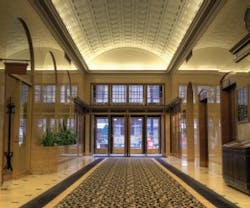Winter’s blustery weather is around the corner, and so are the snow, sand, and salt that go along with it. One of the most effective ways to keep these substances from affecting your floors is to implement a matting system for your building’s vestibule or entrance area.
The trafficking of dry soils across flooring is the main cause of floor wear and the associated maintenance. "The primary advantage of a vestibule matting system is that of dry soil removal and containment, as well as migrating moisture from pedestrian footware," explains Russell Kendzior, founder of the National Floor Safety Institute (NFSI). "By removing and containing dry soil at the point of entry, building owners can keep their floors cleaner and in overall better condition. The prolonged trafficking of dry soils is a leading cause of floor wear and related maintenance costs."
System Specifications
Not all vestibule mats are created equal. Mats are made out of thermoplastic rubber, vinyl, carpet, and recycled products – such as automobile tires. With all of these choices, how do you know which matting system is right for you? "Specifications are based on size, shape, ability to remove soil and water, maintainability, durability, cost, and recyclability," explains Keith Gray, director of technical marketing for The Mohawk Group.
The first factor to consider is location. Will the matting system go inside or outside of the building entrance? A scraper mat that is placed outside of the entrance to your building will act as a first line of defense – it effectively traps and holds soil, sand and ice melt in its deep grooves below the surface and ensures these substances don’t get tracked into the building by occupants. "Specifiers should consider systems with ‘scraper’ function just outside of the building to begin removing heavy accumulations of soil or snow outside of the building," says Gray.
Recessed mats often provide this combined wiper/scraper benefit by providing slats where dry soils can drop through and rest under the mat.
Related Requirements
Maintenance requirements and cost can differ drastically based on the type of mat. "Rubber, plastic, and similar non-carpet mats are often cleaned by sweeping, vacuuming, and simple mopping or scrubbing with water and detergent," explains Gray. "Mats made of carpet require periodic vacuuming and hot water extraction cleaning."
Associated maintenance also includes inspecting the mats to ensure they have not migrated or curled/buckled, as these factors decrease the effectiveness of the matting system and increase the likelihood of related trip-and-fall accidents. "Although carpet mats may appear to be a lower cost approach to soil removal and containment, the related costs of trip-and-fall accidents should be added to their overall costs," says Kendzior.
While the perceived increased cost for installing recessed matting may be a deterrent to choosing these mats, the lower long-term cost of maintenance makes these mats far less expensive in the long run. "Recessed mats generally allow the building owner the benefit of maximum soil removal with the least amount of maintenance time," says Kendzior. "Because recessed mats are fixed in place and do not require frequent inspections, the building owner does not have to expend as much time ensuring that their entryway is safe. Also, recessed matting can remove and contain greater amounts of both dry soil and moisture, thus improving the safety of the building entrance."
A combination of exterior matting and interior matting is often the most effective solution. The exterior mats remove most of the snow, salt, sand, and dirt from shoes, while the carpeted interior mats remove the remainder of the water and soils before occupants set foot on your flooring surface.
"Building owners should be aware of the pros and cons of entrance matting and focus on the end result – that is soil and moisture removal and containment," explains Kendzior. "If a building's current system is not working, the owners need to address the problem by changing the program."
Kylie Wroblaski is associate editor of BUILDINGS.
